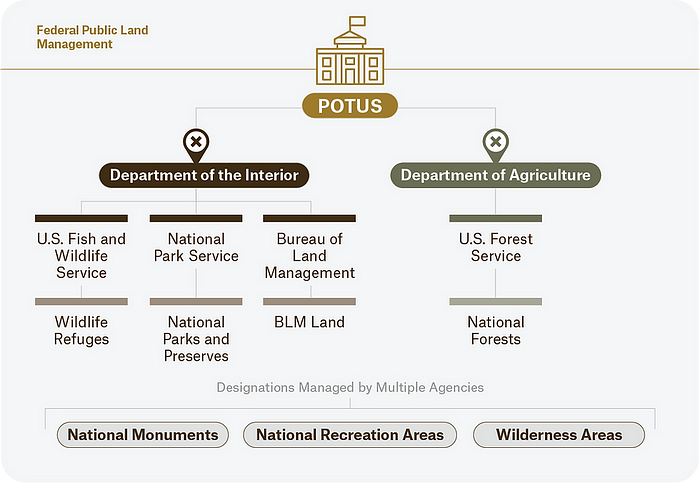Edition 1: Breaking Down Public Lands
Breaking Down Public Lands
What are public lands?
Public lands are areas of land and water that are collectively owned by U.S. citizens and managed by government agencies. Most public lands are managed by the federal government, or by a sovereign tribal nation. More than a third of the total land in the U.S. is public, and combined, federal and state governments manage roughly 840 million acres of public land.
Who manages federal public lands?
Federal public lands and waters are areas of public land and water that are managed by one of eight federal land management agencies. However, most federal public lands are managed by agencies spread across four executive departments of the federal government: the Department of the Interior (DOI), the Department of Agriculture (USDA), the Department of Commerce (DOC), and the Department of Defense (DOD). Below is a list of the four primary agencies and their departments.
National Park Service (NPS) [DOI]
Forest Service (USFS) [USDA]
Fish and Wildlife Service (USFWS) [DOI]
Bureau of Land Management (BLM) [DOI]
The Wilderness Society has created a free curriculum on public lands and can be downloaded here.
How are public lands managed?
The DOI and USDA are responsible for managing most public lands used for recreation. Land designations, specifically federal ones, refer to areas recognized by Congress or the executive branch as nationally significant. They can be managed in a variety of ways depending on their designation and the agency responsible. Each designation falls along a spectrum — from conservation to resource extraction — shaped by agency-specific guidelines that determine permissible uses.
To learn more about federal land designations and who manages them, OnX has created a guide with visuals.
About the author
Connie Is the Director of Content Marketing at Nature’s Playbook. She believes access to the outdoors is essential to a happy and healthy life, and hopes that by sharing her experiences in nature she’ll inspire others to get outside and reconnect with their surroundings and the people around them.




